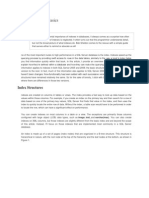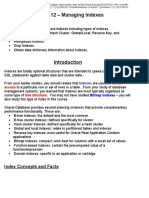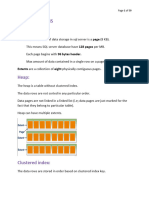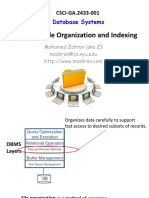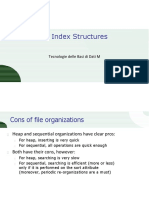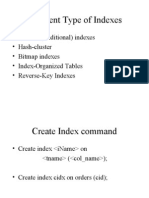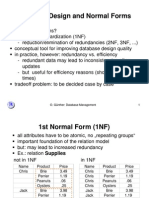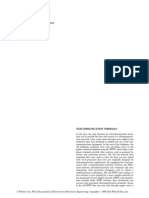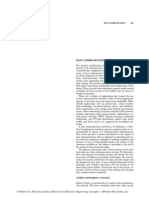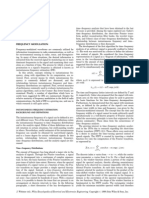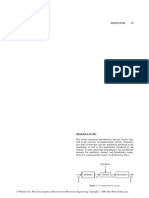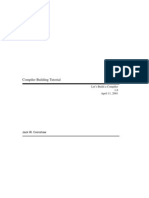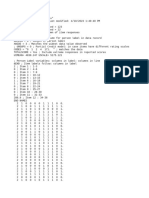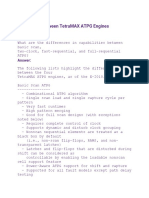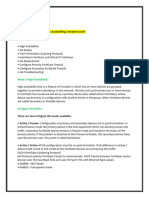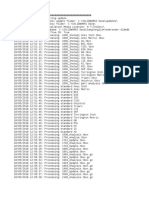IN THIS CHAPTER
Basic Index Structure
WEB 3
Type 1 Indexes
The ability to create indexes on DB2 tables has been around
since the first release of DB2. The first type of index that was
available is now referred to as a type 1 index. Type 1 indexes
were made obsolete when type 2 indexes were introduced in
DB2 Version 4. However, IBM supported type 1 indexes
through Version 5. As of DB2 V6, type 2 indexes can no
longer be used by DB2.
Type 2 indexes are preferable to type 1 indexes because they
eliminate index locking. Furthermore, most newer features of
DB2 require type 2 indexes.
Basic Index Structure
Before examining the specifics of the layout of index data
pages, lets first examine the basic structure of DB2 indexes.
A DB2 index is a modified b-tree (balanced tree) structure that
orders data values for rapid retrieval. The values being
indexed are stored in an inverted tree structure, as shown in
Figure 1.
As values are inserted and deleted from the index, the tree
structure is automatically balanced, realigning the hierarchy
so that the path from top to bottom is uniform. This realign-
ment minimizes the time required to access any given value
by keeping the search paths as short as possible. To imple-
ment b-tree indexes, DB2 uses the following types of index
data pages:
Space map pages Space map pages determine what space is
available in the index for DB2 to utilize.
Root page Only one root page is available per index.
The root page must exist at the highest level
of the hierarchy for every index structure. It
can be structured as either a leaf or a non-
leaf page, depending on the number of
entries in the index.
49 0672326132 Web3 4/20/04 3:27 PM Page PDF 1381
Non-leaf pages Non-leaf pages are intermediate-level index pages in the b-tree hierarchy. Non-
leaf pages need not exist. If they do exist, they contain pointers to other non-
leaf pages or leaf pages. They never point to data rows.
Leaf pages Leaf pages contain pointers to the data rows of a table. Leaf pages must
always exist. In a single page index, the root page is a leaf page.
WEB 3 Type 1 Indexes PDF 1382
Header
C01
D11
Header
E11
Header
D01
Header
B01
Header Header Header Header Header Header
Pointers to table data
FIGURE 1 DB2 index structure.
The pointers in the leaf pages of an index are called a record ID, or RID. Each RID is a
combination of the tablespace page number and the row pointer for the data value, which
together indicate the location of the data value.
The level of a DB2 index indicates whether it contains non-leaf pages. The smallest DB2
index is a one-level index; the root page contains the pointers to the data rows. In this
case, the root page is also a leaf page, and no non-leaf pages are available. This is true for
Type 1 indexes only; no one-level Type 2 indexes exist. A two-level index does not contain
non-leaf pages. The root page points directly to leaf pages, which in turn point to the rows
containing the indexed data values.
A three-level index, such as the one shown in Figure 1, contains one level for the root
page, another level for non-leaf pages, and a final level for leaf pages. The larger the
number of levels for an index, the less efficient it will be. You can have any number of
49 0672326132 Web3 4/20/04 3:27 PM Page PDF 1382
intermediate non-leaf page levels. Try not to have indexes with more than three levels
because they are generally very inefficient.
Type 1 Index Data Pages
Type 1 non-leaf pages are physically formatted as shown in Figure 2. Each non-leaf page
contains the following:
A 12-byte index page header that houses consistency and recoverability information
for the index.
A 16-byte physical header that stores control information for the index page. For
example, the physical header controls administrative housekeeping such as the type
of page (leaf or non-leaf), the location of the page in the index structure, and the
ordering and size of the indexed values.
A 17-byte logical header that stores additional consistency and recoverability check-
ing information, as well as administers free space.
Basic Index Structure PDF 1383
W
e
b
3
Page Header
12 bytes
Physical Header
16 bytes
Logical Header
17 bytes
Page Number
3 bytes
Page Number
3 bytes
Page Number
3 bytes
Page Number
3 bytes
Free Space
Highest Key Value on Page
Highest Key Value on Page
Highest Key Value on Page
Trailer
1 byte
FIGURE 2 Type 1 index non-leaf page layout.
The physical structure of a type 1 index leaf page differs depending on the parameters
specified when the index is created. Type 1 index pages can be broken down into smaller
portions, known as subpages. A type 1 index can be defined as having 1, 2, 4, 8, or 16
subpages. The physical structure of type 1 index leaf pages depends on the number of
subpages defined for the index.
49 0672326132 Web3 4/20/04 3:27 PM Page PDF 1383
For type 1 indexes, increasing the number of subpages can decrease contention, but this
may decrease the efficiency of access to the index data. Specify SUBPAGES 1 for infre-
quently updated type 1 indexed columns.
For a type 1 clustering index, you might want to try setting the number of subpages such
that each subpage contains the same number of rows as the data pages of the tablespace.
This can reduce locking of unrelated data. If the index is not clustered, do not attempt
this, because the corresponding index subpages will contain different rows than the table-
space pages, and no gain in performance will be realized.
Refer to Figure 3 for the physical layout of a type 1 index leaf page with a subpage specifi-
cation of 1. The page header, physical header, and logical header are used for the same
purposes as they are in non-leaf pages. The remainder of the page is used for index entries.
Each index entry is composed of indexed values and RID pointers to the table data.
WEB 3 Type 1 Indexes PDF 1384
Page Header
Physical Header
Logical Header
Index
Entry
Free Space
Trailer
1 byte
Index
Entry
Index
Entry
Index
Entry
Index
Entry
Index
Entry
Index
Entry
FIGURE 3 Layout of a type 1 index leaf page containing one subpage.
Refer to Figure 4 for the physical layout of a type 1 index leaf page with a subpage specifi-
cation greater than 1. A subpage directory replaces the single logical header. This directory
contains an array of pointers used to locate and administer the index subpages. Each
subpage has its own logical header, allowing free space to exist on each subpage.
49 0672326132 Web3 4/20/04 3:27 PM Page PDF 1384
FIGURE 4 Layout of a type 1 index leaf page containing more than one subpage.
The final physical index structure to explore is the index entry. You can create both
unique and non-unique indexes for each DB2 table. When the index key is of varying
length, DB2 pads the columns to their maximum length, making the index keys a fixed
length. A unique index contains entries, and each entry has a single RID. In a unique
index, no two index entries can have the same value because the values being indexed are
unique (see Figure 5).
Basic Index Structure PDF 1385
W
e
b
3
Logical
Header
Index
Entry
Index
Entry
Index
Entry
Page Header
Physical Header
Subpage Directory
Free Space
Trailer
1 byte
Logical
Header
Index
Entry
Index
Entry
Index
Entry
Index
Entry
Logical
Header
Index
Entry
Index
Entry
Index
Entry
Logical
Header
Index
Entry
Index
Entry
Free Space Free Space
Subpage 2 Free Space Subpage 1
Subpage 4 Subpage 3
Additional Subpages
49 0672326132 Web3 4/20/04 3:27 PM Page PDF 1385
FIGURE 5 Index entries.
Synopsis
This appendix is provided for those shops that have not yet converted to DB2 V6 and still
have type 1 indexes. No new indexes should be defined as type 1 and you should immedi-
ately begin to convert all type 1 indexes to type 2 indexes. This is important because type
1 indexes are no longer supported by DB2 as of Version 6.
WEB 3 Type 1 Indexes PDF 1386
Header RID Index Key Value(s)
Unique Index Entries
NonUnique Index Entries
RID RID RID
RID Index Key Value(s)
49 0672326132 Web3 4/20/04 3:27 PM Page PDF 1386
